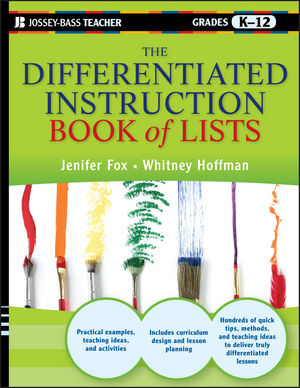The Differentiated Instruction Book of ListsISBN: 978-0-470-95239-9
Paperback
288 pages
August 2011, Jossey-Bass
 |
||||||
The Authors v
Acknowledgments vii
Preface xv
Introduction 1
Section 1 Understanding Differentiated Instruction 5
List 1.1. A Vision for the Differentiated Instruction Classroom 6
List 1.2. One-Size-Fits-All Teaching Versus Differentiated Teaching 7
List 1.3. Small Things That Make a Big Difference 8
List 1.4. Common Misconceptions 10
List 1.5. Differentiate the Materials 12
List 1.6. Differentiate the Task 14
List 1.7. Differentiate the Homework 15
List 1.8. Differentiate Checking for Understanding 16
List 1.9. Differentiate the Outcome 17
List 1.10. Are You Ready for Differentiated Instruction? A Few More Examples of What is Expected 18
List 1.11. Definitions of Concepts Commonly Associated with Differentiated Instruction 20
Section 2 Teaching with the Individual in Mind 25
List 2.1. Building Relationships 26
List 2.2. Strategies to Determine Individual Strengths 28
List 2.3. Interest Inventories 30
List 2.4. Planning with Learning Styles in Mind 32
List 2.5. Multiple Intelligences and Differentiated Instruction 34
List 2.6. Tips for Raising Students’ Comfort Level 35
List 2.7. Tips to Help Struggling Students 37
List 2.8. Tips for Motivating All Students 39
List 2.9. Class Discussion Strategies 41
Section 3 Planning the Differentiated Curriculum 43
List 3.1. Where to Begin and What to Do 44
List 3.2. Tips for Keeping Records for Differentiated Lesson Plans 46
List 3.3. How to Create Differentiated Lesson Plans with Bloom’s Taxonomy 48
List 3.4. Differentiated Assessments 50
List 3.5. Curriculum Compacting: Why and How 53
List 3.6. What are Authentic Choices? How to Plan with Them 55
List 3.7. General Planning Tips for the Differentiated Classroom 58
Section 4 Most Commonly Used Differentiated Instruction Techniques and How to Use Them 61
List 4.1. Tiered Lessons 63
List 4.2. Scaffolding Tools 66
List 4.3. Project-Based Learning 69
List 4.4. Learning Contracts 73
List 4.5. Graphic Organizers 77
List 4.6. Flexible Grouping 83
List 4.7. Learning Stations 86
List 4.8. Rubrics 88
Section 5 Differentiated Classroom Management 91
List 5.1. Arranging the Classroom for Optimal Differentiated Instruction Management 93
List 5.2. Strategies for Differentiated Classroom Management 95
List 5.3. Why Students Misbehave 97
List 5.4. Discipline Strategies 100
List 5.5. Strength-Based Discipline: An Individualized Approach 102
List 5.6. Examples of Strength-Based Versus Deficit-Based Labels 104
List 5.7. Classroom Management and Parental Communication Tips 105
Section 6 Roles and Responsibilities 109
List 6.1. Classroom Teacher 110
List 6.2. Students 111
List 6.3. Administrators 114
List 6.4. Parents 117
List 6.5. Support Staff 119
Section 7 Using Differentiated Instruction Techniques at Different Grade Levels 121
List 7.1. Kindergarten 123
List 7.2. Grades 1–5 125
List 7.3. Middle School 128
List 7.4. High School 130
Section 8 Strategies for Differentiating Language Arts 133
List 8.1. What Exemplary Reading Teachers Do to Differentiate Reading Instruction 135
List 8.2. Strategies to Improve Reading 136
List 8.3. Tips for Differentiating Small-Group Reading Instruction 138
List 8.4. Assigned Reading: Dealing with Low Interest 139
List 8.5. Differentiated Writing Assignments and Strategies 141
List 8.6. Examples of Exciting Differentiated Language Arts Assignments 144
List 8.7. Tips for Differentiating Instruction for English Language Learners 145
List 8.8. Tips for Differentiating Writing Assignments 146
Section 9 Strategies for Differentiating Math 149
List 9.1. Using Reading and Writing to Differentiate Math Instruction 150
List 9.2. Five Specific Ways to Integrate Writing in the Math Curriculum 152
List 9.3. Group Work as a Way to Differentiate the Math Class 155
List 9.4. Ways to Integrate Group Work in the Math Curriculum 156
List 9.5. Math Manipulatives 158
List 9.6. Project-Based Learning Ideas and the Math Class 161
List 9.7. Beyond Traditional Quizzes and Tests: Differentiated Assessments in Math 164
List 9.8. Math Anxiety and Differentiated Instruction 168
Section 10 Strategies for Differentiating Science 171
List 10.1. General Differentiated Strategies for Science 172
List 10.2. Inquiry-Based Instruction and Science 174
List 10.3. Multimedia Projects, Science, and Differentiated Instruction 176
List 10.4. Practical Advice for the Laboratory 177
List 10.5. Technology, Differentiated Instruction, and Science Class 179
Section 11 Strategies for Differentiating Social Studies 181
List 11.1. Gallery Walks 182
List 11.2. Time Lines 185
List 11.3. Political Cartoons 186
List 11.4. Authentic Civic Projects 187
List 11.5. Multimedia Presentations 190
List 11.6. Research Methods 193
List 11.7. Class Discussion 195
Section 12 Strategies for Differentiating the Arts 199
List 12.1. Group Work in the Arts 200
List 12.2. Ways to Help All Students Feel Successful in Art 203
List 12.3. Technology, Differentiated Instruction, and Visual Arts 205
List 12.4. Technology, Differentiated Instruction, and Performing Arts 207
Section 13 Strategies for Physical Education and Health 209
List 13.1. Tips on Using Differentiated Instruction in Physical Education 210
List 13.2. Strategies for Differentiating Skill Training 212
List 13.3. How to Encourage Everyone’s Participation 214
List 13.4. Ideas for Coaches 217
List 13.5. Physical Education and the Unhealthy Student 219
Section 14 New Media Strategies that Naturally Differentiate Instruction 221
List 14.1. How Online Tools Can Help Organize and Differentiate Instruction 223
List 14.2. Ways to Use Facebook in the Classroom 224
List 14.3. Ways to Use Twitter in the Classroom 226
List 14.4. Using Ning in the Classroom 228
List 14.5. Blogging in the Classroom 230
List 14.6. Wikis in the Classroom 234
List 14.7. Cultivating a Positive Digital Footprint 237
List 14.8. Administrative Considerations When Using New Media in the Classroom 239
List 14.9. New Media Uses That are Not OK 241
Section 15 Special Considerations 243
List 15.1. Differentiated Instruction and the Gifted Student 244
List 15.2. Differentiated Instruction and the Advanced Placement Curriculum 246
List 15.3. Differentiated Instruction and the At-Risk Student 247
List 15.4. Differentiated Instruction and Diversity Inclusion 248
References 249
Index 257



